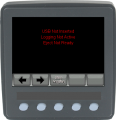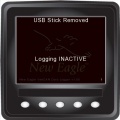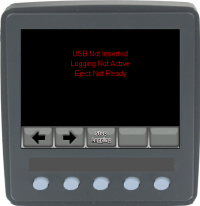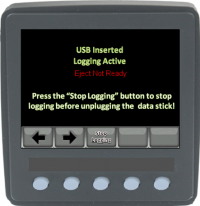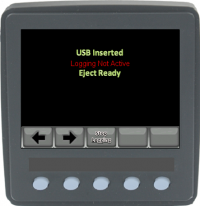NE VeeCAN320 Data Logger: Difference between revisions
(→FAQ) |
|||
| Line 64: | Line 64: | ||
===Data Files=== | ===Data Files=== | ||
The data files are named using log number. The logger will continue to run until there isn’t any space available for creating new files. All data is maintained until removed from the USB stick. | The data files are named using log number. The logger will continue to run until there isn’t any space available for creating new files. All data is maintained until removed from the USB stick. | ||
The size of each file is determined by the logging period. The data file is a text file with all the CAN messages listed. This text file is formatted so it can be imported into almost any CAN analyzing software | The size of each file is determined by the logging period. The data file is a text file with all the CAN messages listed. This text file is formatted so it can be imported into almost any CAN analyzing software. The text file can also be imported into Matlab or Excel, which allows for further data processing. | ||
===Raptor-CAN=== | ===Raptor-CAN=== | ||
Revision as of 18:55, 31 January 2023
New Eagle VeeCAN 320 Data Logger
This logger utilizes a USB 2.0 stick for data storage and effortless data retrieval. Two CAN channels are provided, preconfigured to 250K and 500K, with logging at rates up to 1 ms to make this device an ideal choice for most CAN bus environments. While the unit can function without user intervention, an interface button is provided to allow for multiple logging sessions. This data logging device can survive in the harshest environments due to its robust components.
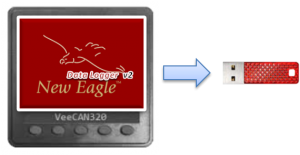
Features
- CAN data logging
- Logging CAN bus data to a USB 2.0 stick
- Provide 2 CAN channels for data logging
- 250K baud CAN 1 Bus, 500K baud CAN 2 Bus
- Data logging is limited only by the size of USB 2.0 stick (sold separately)
- Logging is started automatically when USB stick is plugged in
- Logging session is controlled via a button
- CAN traffic display
- Circular Buffer file system
- Capable of logging at rate of 1 ms
- 320x240-pixel color display for real-time displaying logging status
- 10-32 VDC powered, -20°C to +70°C operating temperature
- Saves as text files, this allows the users to import data into Excel or MATLAB and use a custom script to convert the data into engineering units.
- Logs raw CAN data, all messages on the bus
- RS232 interface and discrete inputs and outputs are available to read discrete sensors or serial data. This function would require a development contract.
USB Stick
This logger can work with any brand and any size USB drive. If the user needs to log a large set of data, we recommend using a large volume USB stick; 16 GB or larger is ideal. The USB status (Not Inserted/Inserted/Eject is Ready) is shown on the logging screen in real-time. The logging is started automatically after the USB is plugged in; if the screen is still showing ‘USB Not Inserted’ in white after the USB drive is plugged in for more than 10 seconds, then plug in the USB drive again and wait for a few seconds until ‘USB Inserted’ is shown on the screen.
Logging onto a USB stick larger than 32 gigabytes will require manual FAT 32 formatting. Fat 32 formatting GUI available here.
"Stop Logging" Button
This logger provides a button to control the logging session; this allows for multiple logging sessions. It is important to stop the logging using this button, otherwise a key cycle will be required to initiate another logging session. Data loss may occur if the user unplugs the USB before pressing this button.
Auto Logging
This unit can log data without user intervention. Keep the USB stick plugged in, then start a key cycle and the logging session will be started automatically.
Logging Rate
This logger has been tested for logging at rates up to 1 ms. We provide two CAN channels: CAN 1 is preconfigured to 250K, CAN 2 is preconfigured to 500K.
Before Logging
The "USB Log Offload" file should be in the USB stick before logging; this file is used for communicating with the logger to detect the USB status.
There are two different versions of the VeeCAN 320 data logger. The two versions of the data logger have very different appearances. If you are uncertain which data logger you purchased, check the background of the display. The versions prior to May 2014 will have a solid background while the more current versions will have the New Eagle logo in the back.
-
VeeCAN 320 Data Logger Display prior to May 2014
- For VeeCAN 320 Data Loggers purchased prior to May 2014, please click here to download the offload file.
- NOTE: After unzipping, the contained file will have the extension .autorun.
-
Current VeeCAN 320 Data Logger Display
- For VeeCAN 320 Data Loggers purchased after May 2014, please click here to download the offload file.
- NOTE: After unzipping, the contained file will have the extension .ars.
How to Log Data
Logging is very easy and straight forward for this device. We offer a color display for logging information. After the logger is powered up, logging instructions will be shown on-screen; after the user plugs in the USB stick (don't forget to put the "USB Log Offload" file in it), the screen will show that the USB is inserted, and the logging has started automatically. When you are done, press the "Stop Logging" button to stop the logging session and prepare the USB stick for removal. Remove the USB stick and plug it into a computer to process the data.
Data Files
The data files are named using log number. The logger will continue to run until there isn’t any space available for creating new files. All data is maintained until removed from the USB stick. The size of each file is determined by the logging period. The data file is a text file with all the CAN messages listed. This text file is formatted so it can be imported into almost any CAN analyzing software. The text file can also be imported into Matlab or Excel, which allows for further data processing.
Raptor-CAN
Raptor-CAN is New Eagle’s simple tool used for communicating with and monitoring CAN systems using a compatible CAN adapter. Using Raptor-CAN with the VeeCAN data logger gives the user the benefit of converting the raw CAN data into engineering units. More information on Raptor-CAN is found here.
Harness
New Eagle offers a harness HARN-CAN-DP-03 (sold separately) to mate the data logger with a CAN bus environment. So far, this harness is only used for the CAN 1 channel. CAN 2 needs an isolated power supply, which must be wired separately in order to utilize CAN 2.
Downloads
- VeeCAN 320 Data Logger
- VeeCAN 320 Lite Data Logger
Webstore
New Eagle VeeCAN 320 Data Logger
New Eagle VeeCAN 320 Data Logger - LITE
Frequently Asked Questions (FAQ)
Q: CAN Channel 1 is not logging on a bus with a baud rate other than 250K. (Datalogger received prior to 10/30/2014)
A: (Versions of the datalogger released prior to 10/30/2014) On bootup, CAN 1's baud rate is initialized to 250K and not the setting specified in "CAN 1 BAUD". The "CAN 1 BAUD" setting initializes correctly in newer versions. Contact New Eagle support to receive updated firmware: support@neweagle.net
Q: Does the VeeCAN family of data loggers have a real-time clock?
A: No.
Q: What are LOG SLOT SIZE and LOG SLOT COUNT in the configuration menu?
A: Slot Size is the size of each log file, whereas Slot Count is the number of log files allowed.
See example below (Note: NO LIMIT will continuously log data at the specified file size):
